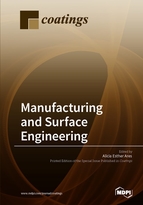Manufacturing and Surface Engineering
A special issue of Coatings (ISSN 2079-6412).
Deadline for manuscript submissions: closed (30 December 2017) | Viewed by 50060
Special Issue Editor
Interests: solidification of metals; processing of metals; mechanical properties of metals; nanotechnology applied to metals products; modelization; corrosion of metals and alloys
Special Issues, Collections and Topics in MDPI journals
Special Issue Information
Dear Colleagues,
The desired properties of surface components include the improvement of different properties, such as aesthetic appearance, oxidation resistance, wear resistance, mechanical properties, electronic or electrical properties, thermal insulation, and corrosion resistance through barriers.
These properties can be enhanced using different methods, such as by adding a coating. Nevertheless, the bulk of the material or substrate cannot be considered independent of the surface treatment.
Potential topics to this Special Issue include, but are not limited to, the full range of surface engineering aspects, i.e., surface integrity, contact mechanics, friction and wear, coatings and surface treatments, multiscale tribology, computational methods, and optimization techniques applied in surface engineering.
Contributions to this Special Issue are welcomed on all subjects of manufacturing and surface engineering. Especially welcome are papers that raise new questions and new possibilities, or examine old problems from a new angle.
Dr. Alicia Esther Ares
Guest Editor
Manuscript Submission Information
Manuscripts should be submitted online at www.mdpi.com by registering and logging in to this website. Once you are registered, click here to go to the submission form. Manuscripts can be submitted until the deadline. All submissions that pass pre-check are peer-reviewed. Accepted papers will be published continuously in the journal (as soon as accepted) and will be listed together on the special issue website. Research articles, review articles as well as short communications are invited. For planned papers, a title and short abstract (about 100 words) can be sent to the Editorial Office for announcement on this website.
Submitted manuscripts should not have been published previously, nor be under consideration for publication elsewhere (except conference proceedings papers). All manuscripts are thoroughly refereed through a single-blind peer-review process. A guide for authors and other relevant information for submission of manuscripts is available on the Instructions for Authors page. Coatings is an international peer-reviewed open access monthly journal published by MDPI.
Please visit the Instructions for Authors page before submitting a manuscript. The Article Processing Charge (APC) for publication in this open access journal is 2600 CHF (Swiss Francs). Submitted papers should be well formatted and use good English. Authors may use MDPI's English editing service prior to publication or during author revisions.






